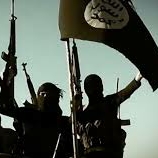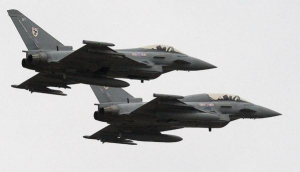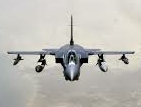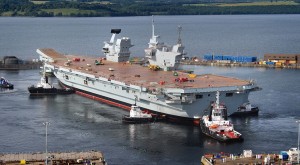Contributed by Sharkey Ward

Air ace Starkey Ward
Falklands War air ace and Harrier squadron commander
[Edited]
Things do not auger well for Britain’s future land-based air participation by the Royal Air Force in the fight against Islamic State (IS) targets.
It is understood that the UK’s Eurofighter aircraft – now dramatically named ‘Typhoons’ – simply lack the necessary independent laser targeting and interdiction ability to destroy the death cult’s ground assets. This was clearly demonstrated during the Libyian conflict – despite a huge investment by the Government to try and give the aircraft a truly multi-role capability.
Continuing such investment is unquestionably throwing more good money after bad.
The Typhoons’ operational limitations leave Britain with the obsolete Tornado as its fighter-bomber. That is also costing the taxpayer huge amounts of money in order to keep some of the airframes operationally capable.
But even more important than wasting taxpayers’ money – and quite another matter – is to deliberately send ill-equipped aircrew “into harm’s way”.
The Tornado would not be able to evade a Russian S-400 surface-to-air missile.
Of course, the risk factor from this and other surface-to-air missile defence systems over contested territory could have been mitigated by the procurement of few A/E-18 Super Growler defence suppression aircraft.
These aircraft are able to identify interrogating enemy air defence radars and blind them by “jamming” and other technologies.
The RAF or Royal Navy could have afforded two of these for the price of one Typhoon or one F35B STOVL aircraft. Such a purchase would have enabled relatively safe operations by Tornado over Syria.
(I hardly dare point out – again – that Britain could have purchased three proven F-18 Super Hornet multi-role fighter aircraft for the cost of one Typhoon or F35.)
The vulnerability of the Tornados’ low-level attack profile to air defences was amply demonstrated way back in Desert Storm when eight RAF aircraft were lost, mainly during operations against Saddam Hussein’s airfields.
Some may remember reliable press reports of a near-mutiny by Tornado squadron aircrew in Kuwait because of their high loss rate and the plane’s ‘suicidal’ attack profile. Allegedly one squadron expressed its firm desire to ‘down tools’ en masse and return to the UK.
Further, both Libya and Afghanistan must be considered operational failures as far as the Tornado is concerned. The aircraft was not reactive to urgent “ground support” tasks, even though it was not opposed by any sophisticated form of air defence – just shoulder-launched missiles and small arms – and it stayed well out of range of these infantry weapons when delivering ordnance.
Indeed, it is little known outside the military that in Afghanistan the original RAF Harrier squadrons would respond to urgent requests for close air support in less than half an hour (wheels off the ground in 15 minutes).
But when Tornados took over, just weeks before SDSR 2010, ground forces were informed by the Tornado hierarchy that all requests for “close air support” had to be submitted 24 hours in advance.

Shockingly, I understand that the Tornados flew lengthy sorties at high level, clocking up the hours to create the false impression that they were being effective in that combat theatre.
Until now in Iraq, RAF Tornado and Voyager missions have remained well above the range of ground-based small arms and shoulder-launched missiles when attacking IS targets.
Some might say unkindly that they are, in the main, boring holes in the sky (just as they did in Afghanistan) to create the impression of some combat utility.
After all, an occasional pickup truck destroyed by an expensive Brimstone missile can hardly be said to be a game-changer in the war against Islamic State.
However, Russia’s introduction of the S-400 anti-aircraft missile into the Syrian theatre is a major game changer (all targets up to 90,000 feet and within a 250 miles range).
If pressed, Moscow might use the missile and, if in Syrian air-space, gallant RAF aircrew could be lost. I am reminded of Guernica and the Spanish Civil War, when Hitler’s Luftwaffe tested its weapons with impunity. Would Putin do the same?
For example, any Western “coalition” aircraft conducting missions over Syria could be ‘taken out’ by the Russian missile and Putin/Assad would no doubt argue that under international law the coalition aircraft had no right to be using weapons of war in sovereign Syrian territory.
The Russians have already alluded to this by criticising some of the air strikes made by the French following the radical Islamist terror attack in Paris.
By default, Putin and the S-400 threat have now ‘created’ a pretty effective no fly zone.
The situation is a complete mess and, as far as Britain’s efforts are concerned, its military is becoming a laughing stock.
RAF Akrotiri in Cyprus is only 70 nautical miles from Syria. Britain owns approximately 100 Typhoon and 75 Tornado aircraft. So why has it been unable to do more in Iraq? The answer is that it has the wrong aircraft with the wrong weapon systems and it lacks any vital AA suppression capability.
This state of affairs says little for those in the RAF who plan British air power and provide the Government with such dreadfully partisan advice.
In the light of all the above (and the Tornado’s dreadful track record) is it not extraordinary that the Government’s Ministry of Defence has seen fit to appoint two Tornado officers to take charge of the new Royal Navy carriers and their air groups?
It hardly bodes well for the future of Britain’s global national security and defence.



